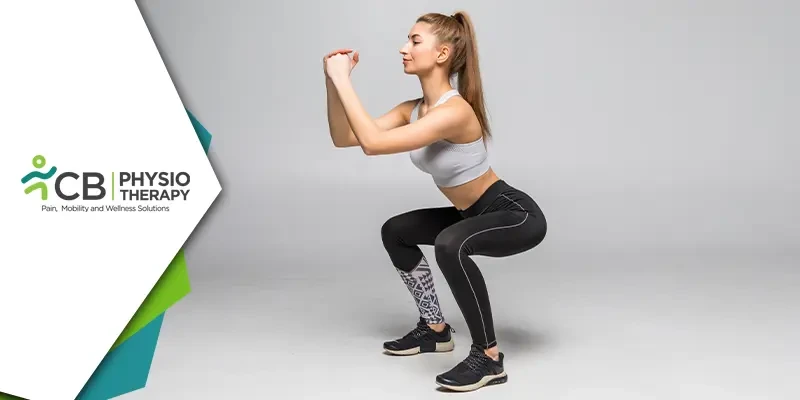If you ask any fitness enthusiast or your physiotherapist about the most effective exercise, then chances are they will tell you it's the "King of the Exercises" - the squat. The squat is a fundamental movement pattern that involves lowering your body towards the ground by bending your knees and hips, then standing back up again. This movement engages multiple muscles in your legs, hips, and core, making it an effective strength training exercise. It is effective for building strength, flexibility, and mobility. However, there is some debate over whether deep squatting is harmful or useful for the body. In this blog, we will explore both sides of the argument and help you make an informed decision about whether to incorporate deep squatting into your fitness routine.
Squats
Squats are a compound exercise, which means they work for multiple muscle groups at once. The primary muscles worked during a squat are the quadriceps (front of the thigh), glutes (buttocks), hamstrings (back of the thigh), and calves. Squats also engage the core, including the lower back and abdominals. Deep squatting is a popular exercise that involves lowering your body into a squatting position until your thighs are parallel or below parallel to the ground.
So, Why are Squats considered the King of Exercises? Here are a few reasons:
Builds Lower Body Strength: Squats are one of the best exercises for building lower body strength. By working the quads, hamstrings, and glutes, squats can help increase your overall strength and power. This, in turn, can improve your performance in other exercises and activities, such as running, jumping, and climbing stairs.
Enhances Athletic Performance: Squats are also great for enhancing athletic performance. Because they work for multiple muscle groups, squats can improve your ability to generate power and explosiveness. This can be especially helpful for athletes who need to sprint, jump, or change direction quickly.
Improves Mobility and Flexibility: Squats require a good range of motion in your hips, knees, and ankles. By performing squats regularly, you can improve your mobility and flexibility in these joints. This can be especially beneficial for older adults who may be more prone to stiffness and immobility.
Burns More Calories: Because squats work for multiple muscle groups, they require more energy to perform than isolation exercises. This means that squats can help you burn more calories during your workout, making them a great choice for those looking to lose weight or improve their body composition.
Versatile Exercise: Squats can be performed in a variety of ways, including with a barbell, dumbbells, or body weight. They can also be modified to target specific muscle groups or to make them easier or more challenging. This makes squats a versatile exercise that can be adapted to meet the needs of almost anyone.
Potential Risks of Deep Squatting
Despite its many benefits, some experts argue that deep squatting can be harmful to the body, especially if done incorrectly. Potential risks of deep squatting include:
Knee injuries: Deep squatting can put a lot of stress on the knee joint, especially if done with poor form or with heavy weights. This can increase the risk of knee injuries such as ACL tears, meniscus tears, and patellar tendinitis.
Lower back injuries: Deep squatting can also put stress on the lower back, especially if done with poor form or with heavy weights. This can increase the risk of lower back injuries such as herniated discs and sciatica.
Hip injuries: Deep squatting requires a significant range of motion in the hip joint, which can increase the risk of hip injuries such as labral tears and hip impingement.
Incorrect form: Deep squatting requires a proper form to avoid injury. If done incorrectly, it can put stress on the wrong muscles and joints, increasing the risk of injury.
Tips for Safe Deep Squatting
If you decide to incorporate deep squatting into your fitness routine, it's important to do it safely to minimize the risk of injury. Here are some tips to help you squat safely:
Start with bodyweight squats: If you're new to deep squatting, start with bodyweight squats to build strength and practice proper form before adding weights.
Use proper form: Keep your back straight, your chest up, and your knees in line with your toes. Avoid rounding your back or allowing your knees to cave in.
Use a spotter or trainer: If you're new to deep squatting or lifting heavy weights, consider using a spotter or working with a trainer to ensure proper form and avoid injury.
Warm-up: Warm up before squatting to loosen up your muscles and reduce the risk of injury.
Increase weight gradually: If you're adding weights to your squat, do so gradually to avoid putting too much stress on your joints.
The degree of squatting recommended for patients may vary depending on their individual conditions and limitations. Here are some general guidelines for recommended degrees of squatting based on common conditions:
- Osteoarthritis.
- Knee conditions like patellofemoral pain syndrome, anterior cruciate ligament (ACL) tears, meniscus tears, and patellar tendinitis.
- Hip conditions like hip impingement, labral tear, bursitis, and femoroacetabular impingement (FAI).
- Ankle conditions like Achilles tendinitis, ankle sprains, plantar fasciitis, and posterior tibial tendinitis.
- Low Back Pain.
It's always best to consult a physiotherapist for individualized recommendations based on the specific pathology and limitations. They can help determine the appropriate degree of squatting for your individual needs and provide guidance on proper form to minimize the risk of injury. The squat is an incredibly effective exercise that should be included in almost any fitness routine. Whether you're looking to build strength, enhance athletic performance, improve mobility, or burn more calories, squats can help you achieve your goals. So, next time you hit the gym, don't forget to pay your respects to the King of the Exercises - the squat.

